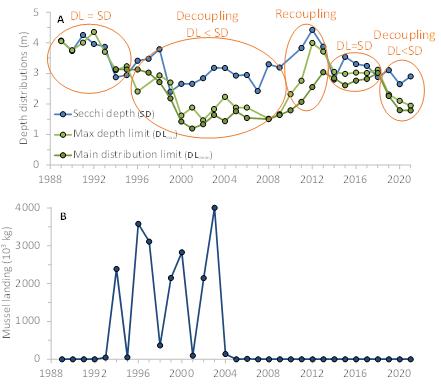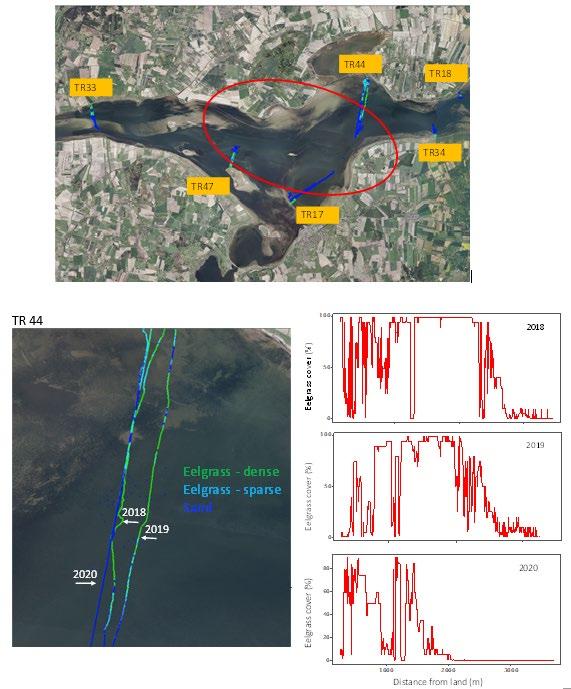
7 minute read
6 Case study of trends in eelgrass following trawling ban in Nibe/Gjøl Bredning, Limfjorden
Coupled information on temporal trends in eelgrass depth distribution, water clarity and mussel trawling activity in Nibe/Gjøl Bredning in Limfjorden serves as an example of how a trawling ban may stimulate eelgrass distribution. Data on eelgrass and water clarity come from the national marine monitoring program and mussel landings are derived from the Danish Fisheries Agency.
At the beginning of the monitoring period, i.e. 1989-1995, no mussel trawling (except in 1994) took place in Nibe Gjøl Bredning, and the lower depth limit of the eelgrass meadows was closely coupled with the Secchi depths (Figure 6.1 A). However, in the following decade until 2004, when a trawling ban was implemented, mussel trawling was intense, with up to 4000 tons of mussels landed annually. During this decade and until 2009, i.e. several years after the trawling ban was implemented, eelgrass depth limits were decoupled from Secchi depths so that the meadows extended to much shallower depths than the light conditions allowed. From 2010 to 2013, the eelgrass depth distribution increased and gradually matched the Secchi depths, first reflected by an extension of the maximum depth limit, then by an extension of the main distribution limit (depth limit of 10% cover). In 2014-2018, i.e. a decade after the trawling stopped, depth limits again matched the Secchi depths. However, despite the continued trawling ban, a decoupling between depth limits and Secchi depths have recently reappeared, indicating new disturbance of the meadows (Figure 6.1 B).
A closer look at the development in the spatial distribution of eelgrass meadows in recent years (2018-2021) reveals that the losses of eelgrass mainly happened centrally in the bay where the three transects (tr 17, tr 44, tr 47) showed major losses of eelgrass along their deeper edges (Figure 6.2, upper panels).
In contrast, the three transects at the edges of the bay (tr 18, tr 33, tr 34) did not show such declines. We illustrate the losses in the central part of the bay with tr 44 as an example (Figure 6.2, lower panels). Here, plots of eelgrass cover versus distance from land over the years 2018-2020 show major losses of deep eelgrass cover between the survey in September 2019 and that in September 2020 (Figure 10, lower panels). The losses extended over large stretches of the seafloor from around 1500 to 3000 m from land, and some meadows at around 1000 m from land were also lost (Figure 6.2, lower panels).

We can only speculate about the cause of these losses. Heat waves could be one potential cause, but there were no heatwaves between 2019 and 2020. Sediment mobility might disturb the meadows, but this would be expected to have most effect at shallow depths closest to the shore. Mussel trawling could also produce such losses, but since there is a trawling ban there is no documentation of such disturbance in recent years.
Figure 6
Upper https://doi.org/10.1007/s12237-020-00765-6.
Map of Nibe-Gjøl Bredning showing the location of monitoring transects for eelgrass; the red circle encloses the transects in the central bay where losses of eelgrass meadows have been recorded in recent years. Lower left panel: Map showing eelgrass occurrence along transect 44 over the years 2018-2020 (and 2021, covered by the 2020 transect). Lower right panel: Eelgrass cover along transect 44 as a function of distance from the shore over the years 2018-2020. The pattern of eelgrass cover in 2021 (not shown) was similar to that in 2020.
We aimed to quantify the potential effect of trawling on eelgrass C-stocks in Danish coastal waters and predict the future effect of a trawling ban on these variables. We applied two datasets (high- vs. low-resolution) on fisheries with bottom contact. These were comparable in their zones of overlap and were, therefore, combined and overlayed with maps of eelgrass distribution and sediment C-stocks (top 10 cm; based on two different C-stock models: an eelgrass C-stock model and a coastal C-stock-model) to evaluate potential effects of trawling. The trawling data included Danish vessels >12 m length while smaller vessels and foreign vessels were not considered.
The analyses showed that trawling with large Danish vessels affects 39.8% of the total study area in Danish coastal waters but only 7.2% of the modelled potential eelgrass area. Even with this relatively limited impact, the results indicate that fisheries with bottom contact can be a contributing factor preventing eelgrass meadows from extending to deeper areas. Eelgrass-associated C-stocks include those in eelgrass biomass and sediments, which are also affected by discontinued eelgrass C-accumulation capacity following loss of meadows. We document large sediment C-stocks within eelgrass areas but equally large or larger stocks outside eelgrass meadows. The analysis detected no significant impact of trawling on eelgrass sediment C-stocks, although a tendency towards lower C-stocks in trawled eelgrass areas was observed. Upscaling the (non-significant) trawling effect identified by the eelgrass C-stock model indicated a trawling impact of <1% of the sediment C-stocks in eelgrass. Moreover, our results indicated a limited effect of trawling on current and future C-stocks in the standing eelgrass biomass (2.4 to 3% of total biomass C-stocks of each scenario) and associated C-accumulation rate (1.9 to 3.8% of the total C-accumulation rate of each scenario). This low impact is due to a non-significant effect of recorded trawling on sediment C-stocks and a limited overlap between the poteial extent of eelgrass meadows and areas with recorded trawling activity. The analysis is insufficient to evaluate the overall effect of trawling on eelgrass C-stocks as it solely included effects of trawling with larger Danish vessels. It should also be noted that the C-stocks represent variable timespan of accumulation, which is not reflected in the estimated effects. Scarce data of coastal C-accumulation rates also prevented an accurate assessment of how trawling impacts C-accumulation rates within and beyond eelgrass meadows, and the lability and fate of eelgrass carbon remobilised by trawling is also unknown. While our modeling at a national scale indicated limited effect of a trawling ban on eelgrass extent, our case study indicated a marked increase in eelgrass cover after a realised trawling ban in a specific study area (Nibe Bredning).
Future studies should aim for high-resolution data for all trawling vessels, for eelgrass distribution and associated sediment C-stocks and C-accumulation rates, as well as for effects of individual trawling events to better quantify potential impacts. Data on the lability of the sediment carbon and its spatial variability within and beyond eelgrass meadows would also contribute to further elucidating how prone to degradation the organic material accumulated in eelgrass sediments impacted by trawling is. However, even with high-quality data, trawling itself may contribute to blur its own potential effect on sediment C-stocks by inducing resuspension and redistribution of sediment. Despite challenges there is a need to better quantify effects of trawling on eelgrass meadows and their important ecosystem functions.
Arney, R.N., Shepherd, A.K., Alexander, H.D. et al. 2021. Soil carbon and nitrogen storage in natural and prop-scarred Thalassia Testudinum seagrass meadows. Estuaries and Coasts 44, 178–188.
Branco, J., Pedro, S., Alves, A. S., Ribeiro, C., Materatski, P., Pires, R., Caçador, I., Adão, H. 2018. Natural recovery of Zostera noltii seagrass beds and benthic nematode assemblage responses to physical disturbance caused by traditional harvesting activities. Journal of Experimental Marine Biology and Ecology 502, 191-202. https://doi.org/502. 10.1016/j.jembe.2017.03.003.
Carstensen, J., Krause-Jensen, D., Balsby, T.J.S. 2016. Biomass-cover relationship for eelgrass meadows. Estuaries and Coasts 39, 440–450 (2016). https://doi.org/10.1007/s12237-015-9995-6
Duarte, C. M., Losada, I. J., Hendriks, I. E., Mazarrasa, I., Marbà, N. 2013. The role of coastal plant communities for climate change mitigation and adaptation. Nature climate change, 3(11), 961-968.
Epstein, G., Middelburg, J.J., Hawkins, J P., Norris, C R., Roberts, C.M. 2022. The impact of mobile demersal fishing on carbon storage in seabed sediments. Global Change Biology 28, 2875–2894. https://doi.org/10.1111/gcb.16105
Friedlingstein, P., Jones, M.W., O’Sullivan, M. et al. 2021. Global Ccarbon budget 2021. Earth System Science Data Discussion 2021, 1–191. https://doi.org/doi:10.5194/essd-2021-386
HELCOM 2019a. Fishing intensity total 2009 surface gear v2. https://metadata.helcom.fi/geonetwork/srv/eng/catalog.search#/metadata/3c317aa4-f2da-4cac-abd9-5194b0cf7208
HELCOM 2019b. Fishing intensity total 2010 surface gear v2.
HELCOM 2019c. Fishing intensity total 2011 surface gear v2.
HELCOM 2019d. Fishing intensity total 2012 surface gear v2.
HELCOM 2019e. Fishing intensity total 2013 surface gear v2.
HELCOM 2019f. Fishing intensity total 2014 surface gear v2.
HELCOM 2019g. Fishing intensity total 2015 surface gear v2.
HELCOM 2019h. Fishing intensity total 2016 surface gear v2.
Holbach, A., Göke, C., Leiva-Dueñas, C., Krause-Jensen, D., Upadhyay Staehr, P.A. In preparation. Spatial distribution of carbon stocks in coastal sediments – On the impact of seagrasses, trawling and environmental conditions.
Krause-Jensen, D., Duarte, C.M., Sand-Jensen, K., Carstensen, C. 2021. Century-long records reveal shifting challenges to seagrass recovery. Global Change Biology 27, 563–575. https://onlinelibrary.wiley.com/doi/full/10.1111/gcb.15440 https://doi.org/10.1007/s00227-014-2558-8 http://dx.doi.org/10.1098/rspb.2015.1537
Leiva-Dueñas, C., Graversen, A E.L, Banta, G.T., Holmer, M., Masqué, P., Stæhr, P.A.U., Krause-Jensen, D. 2023. Capturing organic carbon and nitrogen in eelgrass sediments of Southern Scandinavia. Limnology & Oceanography. doi: 10.1002/lno.12299.
Macreadie, P.I., York, P.H., Sherman, C.D.H. et al. 2014. No detectable impact of small-scale disturbances on ‘blue carbon’ within seagrass beds. Marine Biology 161, 2939–2944.
Macreadie, P.I., Trevathan-Tackett, S.M., Skilbeck, C.G., Sanderman, J., Curlevski, N., Jacobsen, G., Seymour J.R. 2015. Losses and recovery of organic carbon from a seagrass ecosystem following disturbance. Proceedings of the Royal Society B282: 20151537.
Miljøstyrelsen 2019. Fiskeriintensitet fra 2014 – 2018. https://miljoegis.mim.dk/spatialmap?profile=vandrammedirektiv3basis2019 https://miljoegis.mim.dk/spatialmap?profile=natura2000planer3h2021
Miljøstyrelsen 2021. Analyseret fiskeriintensitet 2013 – 2018.
Petersen, J.K. (Ed.), Brooks, M.E., Edelvang, K., Eigaard, O R., Göke, C., Hansen, F.T., Kuhn, J., Mohn, C., Maar, M., Olsen, J., Pastor, A., Stæhr, P.A., Svendsen, J.C. 2020. Andre presfaktorer end næringsstoffer og klimaforandringer – effekter af stedspecifikke presfaktorer på det marine kvalitetselement ålegræs. Dansk Skaldyrcenter. DTU Aqua-rapport Vol. 2020 No. 361. https://www.aqua.dtu.dk/-/media/Institutter/Aqua/Publikationer/Rapporter-352-400/3812021_Andre-presfaktorer-end-naeringsstoffer-og-klimaforandringersammenfatning.ashx
Petersen, J.K. 2021. Andre presfaktorer end næringsstoffer og klimaforandringer – sammenfatning. DTUAqua. DTU Aqua-rapport Nr. 381-2021 https://www.aqua.dtu.dk/-/media/Institutter/Aqua/Publikationer/Rapporter-352-400/381-2021_Andre-presfaktorer-end-naeringsstoffer-og-klimaforandringer-sammenfatning.ash https://doi.org/10.1016/j.marenvres.2022.105570
Román, M., de Los Santos, C.B., Román, S., Santos, R., Troncoso, J.S., Vázquez, E., Olabarria, C. 2022. Loss of surficial sedimentary carbon stocks in seagrass meadows subjected to intensive clam harvesting. Marine Environmental Research 175, 105570.
Röhr, M.E., Boström, C., Canal-Vergés, P., Holmer, M. 2016. Blue carbon stocks in Baltic Sea eelgrass (Zostera marina) meadows, Biogeosciences 13, 6139–6153. https://doi.org/10.5194/bg-13-6139-2016.




